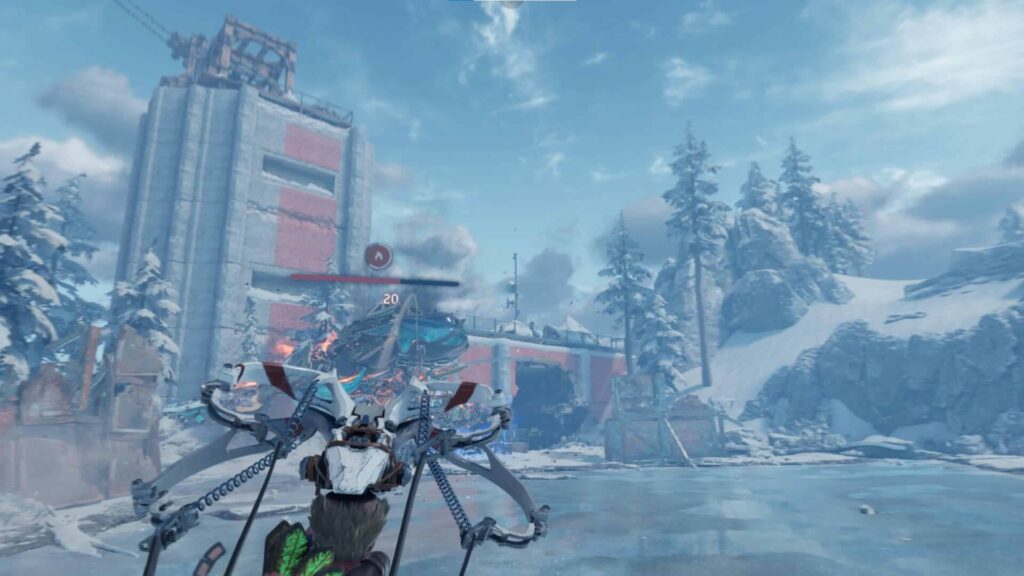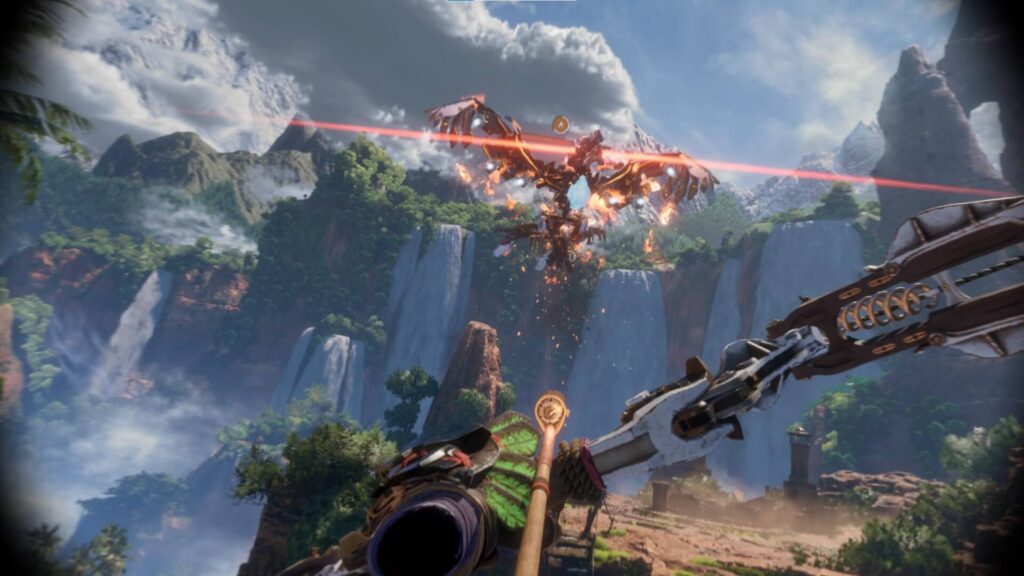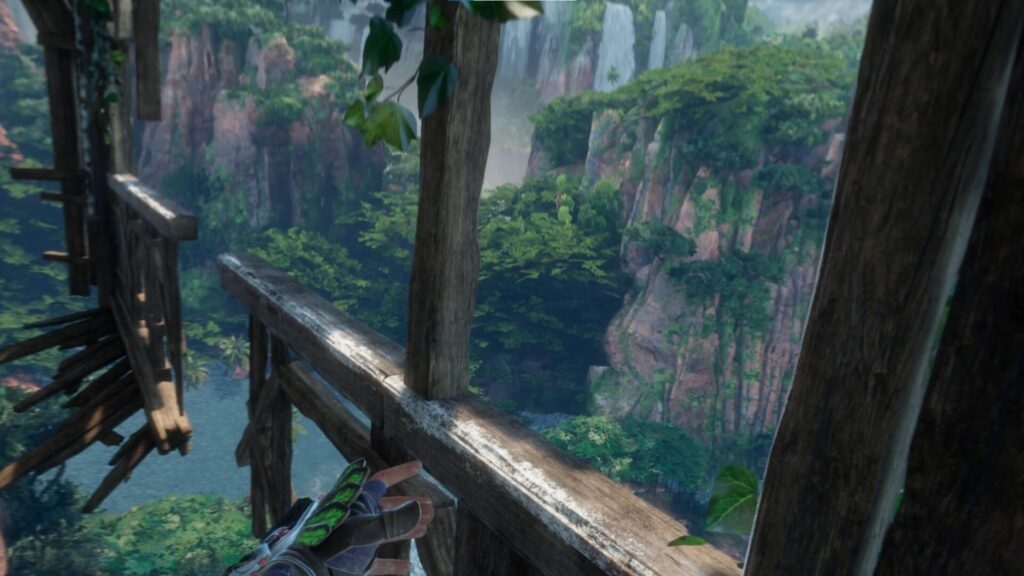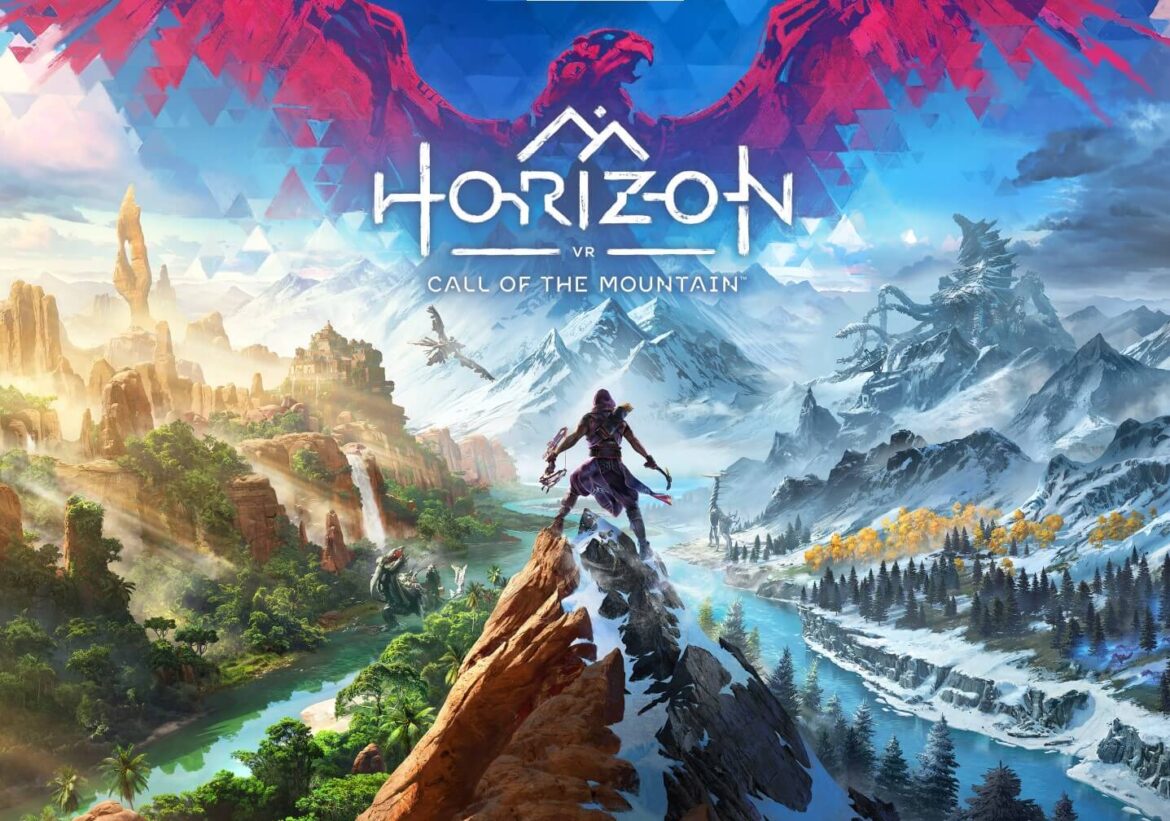Release Date : February 22, 2023
Developer(s) : Guerrilla Games / Firesprite
Publisher(s) : Sony Interactive Entertainment
Platforms : PlayStation VR2
Horizon Call of the Mountain is a highly anticipated game for both VR enthusiasts and fans of the franchise, who enjoyed the great Horizon: Forbidden West. The game has everything it takes to please, with a return to the factions from the second opus, as well as its truly captivating lore. Despite all this promise, we can clearly see that Guerrilla Games, despite being supported by a studio like Firesprite with experience in VR game development (The Persistence in this case), still has a lot to learn when it comes to designing VR games. Here’s our review.
Test conditions: We completed the Horizon Call of The Mountain campaign in 5 hours, taking our time on PSVR2 and not necessarily looking for all the collectables.
Table of Contents
The Call of the Mountains in Absence of a Scenario

In Horizon Call of the Mountain, you play as a new character in the person of Ryas. A former member of the Shadow Carja, our protagonist is captured by this faction, accusing him of treason. In order to obtain a pardon and win his freedom, our hero has a simple mission: to find his brother Urid, who has disappeared, and to investigate a new threat hanging over Sundom.
Let’s face it, Guerrilla Games and Firesprite’s VR title won’t shine for its narrative, which isn’t necessarily engaging. For a start, our new character is extremely flat and not very interesting. It’s hard to admit, but fortunately we meet Alloy at a certain point in the game, which will at least delight fans of the previous two games. However, the game does offer a few interesting twists, notably concerning the identity of the threat hanging over Sundom.
Unfortunately, this is not enough, as the rest of the story fails to live up to expectations. Even if the staging remains impressive and effective, we can’t help complaining about the choppy rhythm of the plot. The same goes for the game’s ending, which offers no real conclusion, while leaving the door open to a probable new opus, if Guerrilla Games is obviously keen to return to a VR experience like this. But if it’s still with Ryas as the protagonist, it’s fair to say that we’re not too excited if it’s coming in the near future.
Horizon vs The Climb

If we compare this new Horizon in VR to The Climb by Crytek, it’s anything but pure chance. Three-quarters of Ryas’s progression, apart from combat, will consist of climbing sequences. Generally speaking, we find the same thing as in Crytek’s title, meaning mimicking gestures to climb various walls and notches, as well as using the various tools at your disposal.
Yes, Horizon Call of The Mountain provides you with new climbing tools as you progress. Once you’ve crafted them in the Carja HQ before starting your missions, you can then put them to good use on your journey. From ice axes to grappling hooks and zip lines, the game is full and varied when it comes to climbing.
However, we can’t say that Guerrilla and Firesprite’s product offers a real challenge in this area. First of all, it’s far too easy to make progress on these climbing phases, given that they lack an endurance system like The Climb. Meaning, you’re practically never going to fall, except in rare cases when bugs creep in to detract from the game’s experience.
So, this is a disappointment, even if the slightly vertical level design does provide a pleasant change of scenery. This clever mix of classic climbing, the use of ice axes to reach the next hold, and even the grappling hook, is really something special to experience. This positive feeling is only an illusion, since the game quickly becomes repetitive, and the above challenge is practically absent.
Horizon Call of the Mountain also fails to make the most of its inventory system. To select your various tools, you have to open the inventory by pressing a button, then make your choice with the joystick, and then press another button to finally benefit from the desired tool, sometimes with the opposite hand held by a hook point. Let’s face it, the inventory system is just plain messy, and it’s common to go over it several times before being able to select the accessory you need to proceed.
Smashing Primitive Machines While Making Coffee

Besides the climbing, which remains a bit of a mixed bag, the game at least takes care of its combat. In particular, combat is in the form of arena battles, where Ryas can move around and dodge attacking machines from the side. Plus, our hero has two weapons at his disposal, including a bow with various elemental arrows (fire, electricity, shockwave, or precision), as well as a slingshot that can throw anything from a single stone to various fire or ice projectiles.
All this makes combat similar to the previous games, or almost. The primitive pieces of junk will always have a life bar to damage to eliminate them. And you’ll need to target their weak points and remove their shells to do much more damage. This strategic aspect of the game is quite pleasant, and the battles are exciting and fast-paced, offering excellent controller sensations with archery and slingshot projectiles. The only thing we regret is the limited range of weapons.
While combat is highly enjoyable, it’s ultimately a little messy. This is due to calibration bugs that can sometimes be annoying when it comes to putting an arrow in the bow and then adjusting your target, or even motion tracking that goes haywire even when the room is bright enough. These are all bugs that tarnish the experience of the entire game, which features some brilliant mechanics for fighting machines and the many iconic bosses of the franchise ( StormBird, Thunderjaw, etc.). However, the dodging system could have been better, but it remains well-designed.

Among the other annoying pitfalls is the improvements section, which does the bare minimum. Although it is possible to restore health by eating some of the available fruit or directly craft elemental arrows once the ammunition types have been collected, the rest is ultimately under-exploited. Starting with the absence of any bow or sling upgrades, which are replaced by sketchy uninteresting crafting. The same goes for upgrading our character’s armor, which is limited to finding badges, and then benefiting from a little more health. All this is really under-exploited, and while the fighting phases are based on the same mechanics from the previous Horizon games, the whole thing is still quite basic in its approach.
Having said that, we can console ourselves with a few brilliant ideas, and a structure that manages to keep us on our toes at least. Among the very few good ideas are the infiltration phases. Here, it’s possible to sneak from bush to bush, in order to avoid the primitive robots scanning the surrounding area. The result is a series of small sequences that try to vary the game’s progression as much as possible, but are limited to wavering between climbing and bow or slingshot battles. As for the level design, it remains linear overall, but still offers a nice verticality, and sometimes alternative paths. However, these are no more than a farce, since they all lead to the same point…
Last but not least, there are “puzzles”, with big quotation marks. These simply involve repairing mechanisms that need to be found in order to continue your journey, and… that’s it. There’s nothing more to it, and we’d have liked these puzzles to be more elaborate… In short, there are many good ideas that, in practice, fail to be exploited to their full potential, which is a complete waste.
Hole-In-The-Wall Modes for a Short Lifespan

The title offers several side modes. As you wander around the Shadow Carja HQ, you’ll be able to talk to certain characters with dialogues that don’t add anything, but you’ll also be able to reach a challenge hub. This serves no purpose other than to shoot arrows and try your hand at climbing, in order to achieve the best possible score. As you can see, the challenge mode is so marginal that you’ll only be there for a short time.
The Machine Safari is another mode which, again, isn’t very exciting. As the name suggests, you’ll be on a boat in the company of another character from the game, who will show you, for 5 minutes, all the mechanical monsters you encounter in the game. In other words, this contemplative mode will ultimately be reserved only for players testing VR for the first time. It’s not really interesting, except as a way of demonstrating the PSVR 2’s potential in terms of resolution and graphical possibilities.
Beyond the modes, Horizon Call of the Mountain has a good idea of including many gameplay options to offer personalized comfort to each player. You can play standing up or sitting down, use eye tracking or not, and adjust the controls. Meaning, you can either use movement by holding down a key, or simply use the joystick to move forward. Basically, there’s something for everyone, and the eye tracking is highly calibrated, super-responsive, and efficient.
Finally, for the lifespan, Horizon Call of The Mountain is too short. While some VR games today can easily reach ten hours or more, Guerrilla Games and Firesprite have the nerve to offer us an experience that can be completed in 5 hours, by taking your time, for a fairly high price at the time of its release, unless you’ve purchased the PSVR pack with the game, it’s well worth it. You can indeed go back to previous missions to pick up a few collectibles, but there’s virtually no point in going back to the game.
The Beauty of the Mountain

There are plenty of positives to be found in this review, starting with the game’s impressive graphics and artwork. The title is already a fine technological showcase for the PSVR 2, as Sony’s new headset not only delivers striking backgrounds, but also a striking graphical look, from the effects to the textures to the clean modeling of characters and creatures. The resolution is equally impressive, showing that PSVR 2 clearly has what it takes. Immersion is also a great success, with the pleasure of getting up close and personal with these numerous metallic creatures. On the other hand, the title isn’t exactly well optimized, with a few calibration bugs, display delays on textures, and slight slowdowns that are a bit of a disappointment.
On the other hand, the artistic side of Horizon Call of the Mountain is as magical as Horizon: Forbidden West. The mountain and snowy scenery is literally breathtaking, and the VR immersion enhances it even further. There’s no denying that the artistic direction is as coherent as ever, and once again a sight to behold. The soundtrack is also top-notch, with top-quality voiceovers and, above all, music that always gives you goosebumps, Guerrilla and Firesprite’s product sticks faithfully to the sound ambiance of previous games. In fact, nothing negative can be said about this aspect, as it seems so close to perfection.
Conclusion
Horizon Call of the Mountain is not a bad game, but it’s not great either. By insisting on drawing inspiration from the many VR games already released, the software has perhaps forgotten to focus a little more on the gameplay that makes the previous two Horizon games so special. Although we’re in familiar territory with rewarding strategic confrontations, combined with a light RPG touch, we have to admit that the game is a disappointment in terms of its progression and, above all, its difficulty, which is both repetitive and lacks challenge. Climbing and combat seem to be under-exploited, and fortunately, the title manages to hold its own with an occasionally brilliant structure, as well as an artistic, technical, and sound direction that once again deserves praise. Horizon Call of the Mountain doesn’t really lack much to be a great VR game, but the result is a AAA production that repeats itself, while also being very short and, above all, sold at a high price. Sadly, the title also loses interest once it’s finished, and the story is missing something on every level. A must-have if you love the Horizon franchise and you own a PSVR 2, but certainly not at full price.
